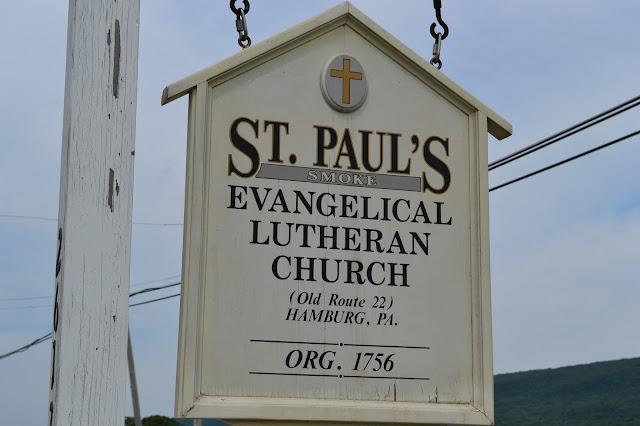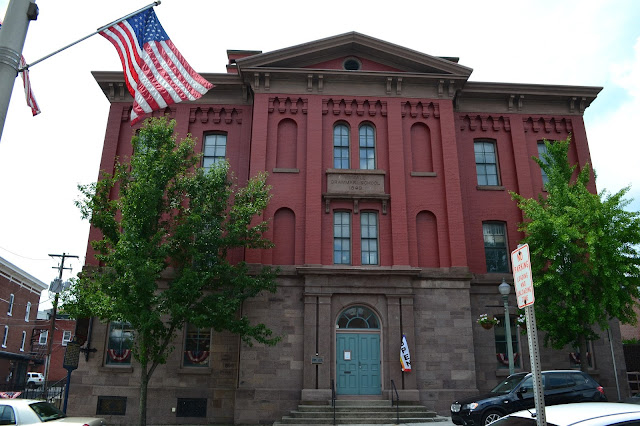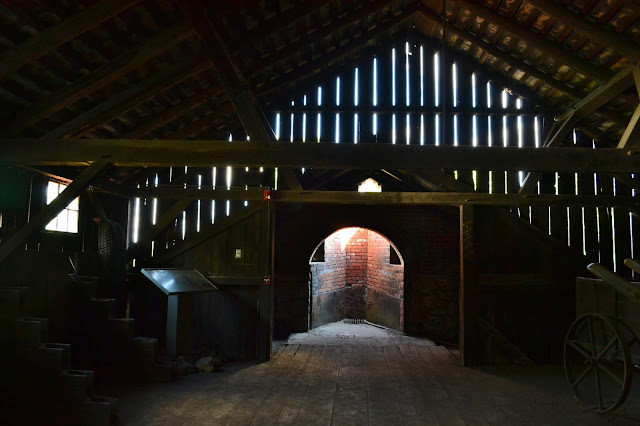Whether you are trying to find covered bridges on back country roads, or searching through old records to find just that one name and date, it takes some navigating. We did a lot of that today.
Skipping a morning walk today, and armed with a local map and brochure, we headed out into the country on a treasure hunt - finding covered bridges.
You don't find covered bridges on highways. The Pleasantville Bridge was so pleasantly surrounded by lush trees and old homes that it was hard to photograph.
I almost stepped on this as I was taking photos. I had to look it up to confirm that it is a cicada, since we don't have them in our neck of the woods, but I sure heard them buzzing in the trees by the bridge.
Of course we were in farm country again, and we like to identify crops. We think this is soybeans. And more corn, of course.
The Griesemer's Bridge was right in a farm, with the old mill on one side, and cows on the other.
The small town of Oley was very picturesque.
The stone building is the remains of the mill at the Kutz's Mill Bridge.
Yes, I did get out and walk through every one of them.
The Dreibelbis Station Bridge looked at first like it was the private driveway of this lovely old home.
Yesterday we found confirmation of a family wedding in 1806 preformed by the pastor of this church, St. Paul's (Smoke) Evangelical Lutheran Church. Today we found it.
The word (Smoke) in the name has an uncertain history. Either it refers to the smoke coming through the cracks in the first old log structure, or it refers to the fact that the men stood around and smoked while waiting for the circuit pastor to arrive.
We drove through historic Hamburg, and then north through the gap in the Blue Mountain ridge of the Appalachians.
On the other side we found another important family history church, the "Red Church", or Zion's Lutheran and Reformed Church.
It's hard to read the oldest date, but there are records going back to 1755.
On to Pottsville, where we were ready when the Schuylkill County Historical Society opened at 1:30.
It is housed in an old Grammar School for girls, dating to 1863.
Just one of the volumes of records we navigated here.
We still do not have the proof we seek, but we got a few more bits and pieces to the puzzle.
The Schuylkill County Courthouse is quite grand. We didn't go in here, but we did go to the library nearby.
But by then we had found all there was to find for now, and we were weary, so we quit for the day, and found an alternate route to take back to Reading and our hotel.
After dinner I went for a twilight walk in a neighborhood on a hill above our hotel. I saw fireflies! That's another bug we don't have at home.
Wednesday, July 31, 2013
Tuesday, July 30, 2013
Old Stuff
Just who is Jonas Tyson? Is he Tom's great, great, great, great grandfather? Is he really Susanna's father? We know she is his great, great great grandmother.
Tom has been working almost exclusively on that question in his genealogical research for the last two years. We hoped for some answers today. While there is still not a definite answer, we did get a bit more evidence to the affirmative. And he did find the marriage notice in an old Reading,PA newspaper confirming a marriage.
We spent the morning here, where Lisa was an enormous help in finding material we could use. Here we did the more basic research, and made several discoveries.
We spent two hours in the afternoon here, where we confirmed what we had found, and cleared up a few mysteries We now have information to enable us to visit a church that probably figured in the history of this family line.
All of this is new to me, but I helped search records for names and dates.
Getting to these places took us into historic Reading. We did a short walk about to see a church we had been reading about all morning.
Across the street and all around were old row houses, and more church steeples.
Yarn bombing.
The Genealogical Society is located in this building, which we were calling the "Google" Center, until we were corrected in the gift shop. It is an old "goggle" factory, makers of protective eye ware, and is now a center for arts.
I was very pleased that we still had time to make it to Hopewell Furnace National Historic Site. I do love following those brown national park signs!
Butterflies floated and fluttered and landed on the flowers outside the visitor's center.
Hopewell Furnace was established in the early 1770's as a charcoal fired smelter for iron for making cast iron.
Wood from the forests was harvested and burned down into charcoal.
The charcoal was hauled to the furnace in wagons.
It was cooled and stored.
Workmen hauled it to the furnace mouth where it was dropped down into the fire along with Iron ore and limestone.
At the bottom, the slag was channeled off and the molten iron was ladled for casting in molds.
The water wheel worked the bellows to add air to the fiery mix.
The iron master lived in luxury.
Two major products of the furnace - cannons and cast iron stoves.
Tonight we are in our hotel in Reading, not historic this time, but adequately comfortable.
Tom has been working almost exclusively on that question in his genealogical research for the last two years. We hoped for some answers today. While there is still not a definite answer, we did get a bit more evidence to the affirmative. And he did find the marriage notice in an old Reading,PA newspaper confirming a marriage.
We spent the morning here, where Lisa was an enormous help in finding material we could use. Here we did the more basic research, and made several discoveries.
We spent two hours in the afternoon here, where we confirmed what we had found, and cleared up a few mysteries We now have information to enable us to visit a church that probably figured in the history of this family line.
All of this is new to me, but I helped search records for names and dates.
Getting to these places took us into historic Reading. We did a short walk about to see a church we had been reading about all morning.
Across the street and all around were old row houses, and more church steeples.
Yarn bombing.
The Genealogical Society is located in this building, which we were calling the "Google" Center, until we were corrected in the gift shop. It is an old "goggle" factory, makers of protective eye ware, and is now a center for arts.
I was very pleased that we still had time to make it to Hopewell Furnace National Historic Site. I do love following those brown national park signs!
Butterflies floated and fluttered and landed on the flowers outside the visitor's center.
Hopewell Furnace was established in the early 1770's as a charcoal fired smelter for iron for making cast iron.
Wood from the forests was harvested and burned down into charcoal.
The charcoal was hauled to the furnace in wagons.
It was cooled and stored.
Workmen hauled it to the furnace mouth where it was dropped down into the fire along with Iron ore and limestone.
The water wheel worked the bellows to add air to the fiery mix.
The iron master lived in luxury.
Two major products of the furnace - cannons and cast iron stoves.
Tonight we are in our hotel in Reading, not historic this time, but adequately comfortable.
Subscribe to:
Posts (Atom)





































































